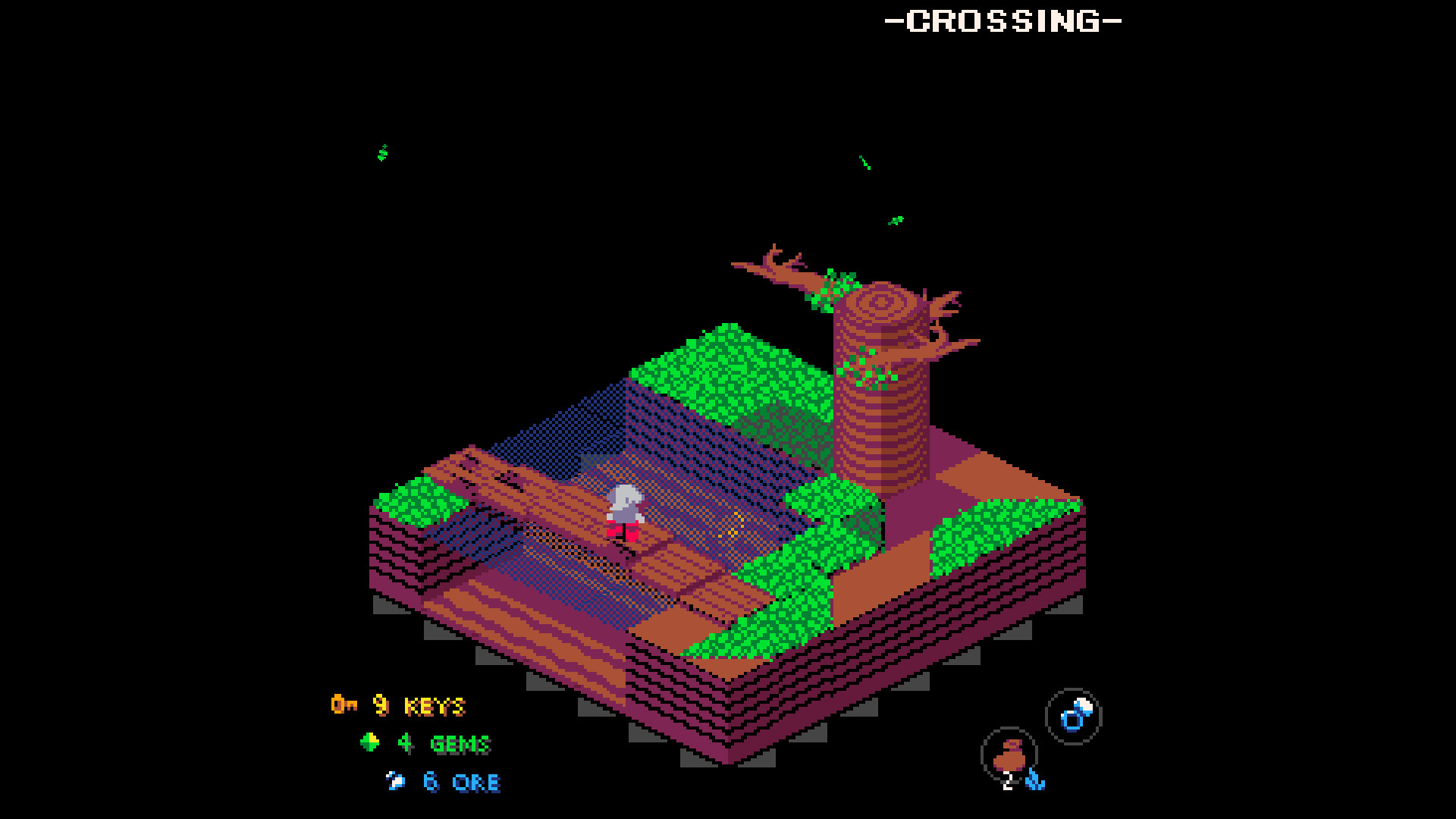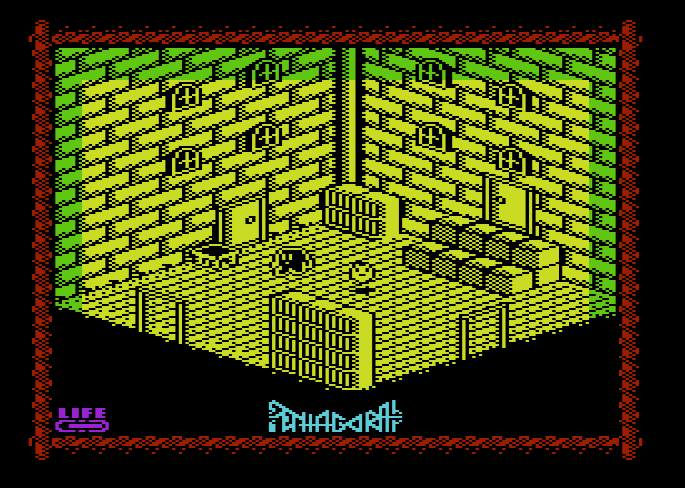Taxonomy of Virtual Spaces
My work posits that digital games can be understood as expressions of different spatial paradigms, defined as the stylistic visuo-spatial configuration of a virtual space and the player's affordances of navigation through that virtual space. In other words, how the game space is drawn to the screen and how the player can move their avatar through that space. This creates a framework for creating a diachronic history of digital games through changing aesthetic styles through time (or, and "art history" of video games).
Admittedly, the concept of spatial paradigms can be difficult to grasp and is often confused with video game genres. The following is an example of such a paradigm intended to help clarify the concept.
Knight Lore and the Birth of "Filmation"
Brothers Chris and Tim Stamper are now best known as the founders of Rare, the games studio that was one of the first western studios to develop for Nintendo systems. Rare created hit titles like R.C. Pro-Am (1988, NES), Battletoads (1991, NES), Donkey Kong Country (1994, SNES), Killer Instinct (1994, arcade), and the genre-defining GoldenEye 007 (1997, N64). Before Rare, the Stamper brothers founded Ultimate Play the Game, a small studio that created games for home computers that were popular in the UK in the early 1980s.
In 1984, the Stamper brothers developed a new graphic technique that combined "pixel dimetric" graphic projection with image masking to allow on-screen objects to overlap one another without flickering. They named their new technique "Filmation"* and used it to develop Knight Lore (1984), the first of several action-adventure games for the ZX Spectrum with platformer gameplay in a vast 3-D environment for the player to explore.
* Note that this technique has nothing to do with the Filmation production studio, creators of animated series like Fat Albert, He-Man, BraveStarr, and She-Ra, along with live-action shows like Secrets of Isis, Ark II, and The Ghost Busters (not to be confused with Ghostbusters). Filmation's production building loomed large in my childhood home town of Reseda. I likely would have tried to get a job there, but they shuttered their doors while I was still in high school.
 |
| Knight Lore (1984, Ultimate Play the Game, ZX Spectrum) |
The Filmation technique was likely inspired by earlier titles like Q*bert (1982, Gottlieb, arcade game) and another "isometric" action-adventure game for ZX Spectrum, Ant Attack (1983, Quicksilva). However, Knight Lore's visual fidelity and large, detailed gameplay space was unprecedented for ZX Spectrum (a.k.a. "Speccy") users. Reviewers were astounded by the game's "glorious 3D" graphics and heralded it as "probably the best game yet produced for the Spectrum" ("Knight Lore Review," Crash, vol. 1, no. 12, Dec 1984, pp 16-17). Critic Steve Cooke stated that "the 3D effects manage to generate a real sense of 'being there'" ("Screen Test," Personal Computer Games, no. 14, Jan 1985, pg. 53). 10 years after the game's release, some critics were declaring that Knight Lore "represents the greatest single advance in the history of computer games" ("Retroview," Edge, no. 12, Sep 1994, pg. 77).
While the last point may be chocked up to hyperbole, it is clear that this new graphic technique was an important technical and stylistic achievement in conveying a complex 3-D space on a limited home computer with unusual graphics restrictions.
ZX Spectrum Graphics
 | |
|
The ZX Spectrum's image resolution was 256 x 192 (compare to the NES/Famicom full screen resolution (with some overdraw) of 256 x 240) and the image would be drawn to the screen with a thick border around the edge** (see Altered Beast image, above). The 256 x 192 image is divided into a 32 x 24 grid of 8 x 8 pixel "blocks" of graphics. For each block, there can be a palette of only two different colors (often black and another color). This can create color bleed when different game objects overlap one another. In the above image, the colors from the main character's green boots, yellow skin, and cyan clothing all bleed into the surrounding gray background in the same graphic blocks.
** Note that the border has been removed from other screen shots on this page.
"Filmation" Spatiality
A grid of magenta lines shows the grid of graphic blocks in the Knight Lore screen shot above. The Stamper Brothers nearly eliminated color bleed by deciding to have the entire gameplay section of the screen use the same palette (though the palette changes from room to room). As you can see, the HUD at the bottom of the screen is divided in such a way that each element is separate from neighboring elements that use different color palettes. The only exception is one of the sunrays in the lower right that is partially drawn in red instead of yellow where it is in the same block as the red frame element.
I've drawn other magenta lines to show the edges of the room's navigable gameplay space, a sort of squashed cube. The edges of the space are defined by the locations of doors in the four walls. The room floor is an 8 x 8 grid of square "tiles"*** (each tile is the size of one of the blocks in the image above) where objects may be placed and the edges are defined by imaginary lines extending from the edges of the doorways. Characters and objects may be stacked atop each other, climb, fly, or jump to become elevated in this fully three-dimensional space.
*** Note that corridor floors in the game are 4 x 8 tiles in size. Doors may be found at the ends of corridors, but not along the long walls.
The player must explore explore the wizard's castle in the game, one room or corridor at a time. Knight Lore uses the "page flip" technique of frame mobility across the game world, one screen at a time.
"The screen is the basic unit of space in videogames, since it frames the interface." (Clara, F.-V., P., Z. J., & Michael, M. (2005). "Evolution of Spatial Configurations In Videogames." Paper presented at the DiGRA '05 - Proceedings of the 2005 DiGRA International Conference: Changing Views: Worlds in Play)
Frame mobility was a major advance in creating a sense of larger space in video games. Many early games are limited to what can be displayed on a single screen. A character moving to the edge of the screen might wrap around to the other side of the screen, creating a toroidal (like Spacewar!) or cylindrical (like Pac-Man) topology, but there was no space beyond the screen. Designer Warren Robinett needed more than one screen to display the vast world of Adventure (Atari, 1980, Atari VCS console game). He was one of the first to use the "page flip" technique to move the player's framing device from one region of game space to another. When the player's avatar reaches the edge of one screen, they reappear on the opposite edge (much like in a game with "screen wrap") with the screen displaying a different "room" of space. Before smooth-scrolling frame mobility became commonplace, this technique was used in many other important "adventure" games on consoles, like Pitfall (Activision, 1982, Atari VCS) and The Legend of Zelda (Nintendo, 1987, NES (1986, Famicom Disk System)).
In Knight Lore's case, the player avatar moves the frame by entering a doorway at the edge of a room or corridor. These interconnected rooms are not all at the same elevation, and after leaving one room on the ground floor the player may find themself on a ledge high up the wall in the next room.
Some rooms in Knight Lore toy with the player's limited spatial information due to the fact that they can only observe the space from one angle, leading to some ambiguities when game objects overlap. In the image above, the crystal ball the player needs to reach appears to be atop a two-block tall stack of blocks. The player can only jump up one block in height, so this seems to be impossible. Actually, it is a winding "staircase" of blocks that the player can easily navigate to reach the top, once they realize the spatial organization of the blocks. There are a number of navigation puzzles with ambiguous visuals like this in the game.
The Longevity of the "Filmation" Spatial Paradigm
 |
| From Spatial Paradigms of Digital Games (Rowe, unpublished) |
Ultimate Play the Game and the Stamper brothers continued to use their Filmation "engine" to create more adventure/platformer games, like Alien 8 (1985) and Pentagram (1986). Their "Filmation II" engine changed the paradigm with smooth-scrolling frame mobility for Nightshade (1985) and Gunfright (1986).
Many other games copied Ultimate Play the Game's spatial paradigm in the years that followed, especially games for the ZX Spectrum. Bo Jangeborg developed the "Worldmaker" system for his games Fairlight (The Edge, 1985) and Fairlight II (1986). Paul Shirley's Spindizzy (Electric Dreams, 1986) combined a Filmation adventure with the momentum-based movement of Marble Madness (Atari, 1984, arcade game). Jon Ritman and Bernie Drummond stayed close to the Stampers' Filmation aesthetic when they created Batman (Ocean Software, 1986) and Head Over Heels (Ocean Software, 1987). Ritman and Drummond later joined the Stampers at Rare to create another game with the same structure, Monster Max (1994, Game Boy handheld).
The Filmation paradigm remained relevant as the ZX Spectrum and its 8-bit brethren gave way to powerful new 16-bit computers with advanced graphics capabilities. The Bitmap Brothers**** created Cadaver (1990), in which a knight explores the mysterious Castle Wulf (note that Knight Lore's prequel game is called Sabre Wulf (1984)). Solstice (CSG Imagesoft, 1990) brought Filmation-style puzzle/platforming in a magical castle to Nintendo's NES console. The Pickford brothers (Ste and John) worked on the sequel for the Super NES console, Equinox (Sony Imagesoft, 1994 (1993, Super Famicom console)).
**** Note that unlike the Stamper brothers and the Pickford brothers, I don't believe that The Bitmap Brothers was founded by actual brothers.
 |
| Elephantasy: Flipside (Benjamin Maksym, 2023, Windows XP game) |
This spatial paradigm continues to have relevance to this day. Elephantasy: Flipside (2023) is a puzzle/platforming adventure game for Windows in which a tiny elephant named Belle must collect items, unlock abilities, and explore a vast, fantastic, 3-D game world.
[Update 8/15/23]
Another relatively recent example is Pentagorat (2016), programmed for the VIC-20 computer. A Commodore 64 sequel, Pentagorat II, is currently in development.
[End Update]
[Update 10/12/23]
Yet another relatively recent example is Melkhior's Mansion (2020) for modern computer systems. The garish color palette is designed to closely emulate the limited colors of the ZX Spectrum. The game is freely available on itch.io and directly references some of Ultimate Play the Game's earlier titles. The developer had been working on a version of the game for the old ZX Spectrum computers, but had to quit recently due to the "cranial abuse" it was causing them.
[End Update]
Defining the "Filmation" Spatial Paradigm
The following definition defines the visuo-spatial configuration:
Continuous Spatiality
3-D Gamespace
Rectangular Topology
Gravity - Down
Frame Mobility:
Diagonal Direction
Discrete (Page Flip)
Agents - 30° Dimetric
Environment - 30° Dimetric
Background/Foreground - N/A
The terminology system to define player navigation affordances is still in development:
Player Navigation Affordances:
Walk
Jump
Diagonal Direction










No comments:
Post a Comment